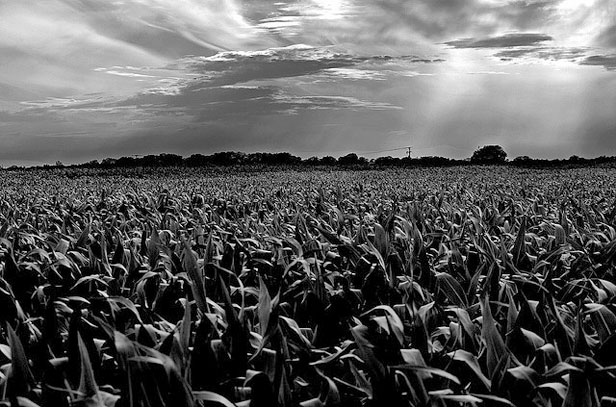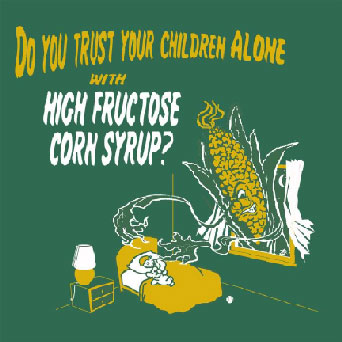 Dark harvest: A cornfield destined for ethanol.Photo: Big Grey Mare
Dark harvest: A cornfield destined for ethanol.Photo: Big Grey Mare
Like countless politicians before him, Obama is striving to shore up his political support in the Midwest by brandishing goodies for the ethanol industry. There you go — scrambling to check on baseball scores or celebrity gossip. (That is, unless you farm a few thousand acres of corn or run an ethanol plant, like so many Grist readers.) I know, I know, even my editor groaned when I said I was writing about ethanol again. But this will be riveting, I promise!
In a speech last week, Tom Vilsack, Obama’s USDA chief, underscored the administration’s fierce commitment to ethanol by promising more than $1.5 billion in gifts to the industry. He also urged Congress to extend the $0.45/gallon tax break, due to expire in December, currently enjoyed by the industry — a perk that will cost taxpayers about $6 billion this year.
But this isn’t your father’s mindless ethanol boosterism. It’s a new kind … although I’d argue it remains quite mindless.
There’s one corn every day
In the past, to appease the ethanol gods, politicians had to sing the praises of corn-based ethanol. But the Energy Act of 2007, with its highly aggressive “renewable fuel standard” mandates for ethanol usage, have upped corn-based ethanol production to 13 billion gallons (vs. less than 2 billion gallons, as recently as 2001). Ethanol is already taking more than a third of the corn crop; if production levels haven’t reached their limit, they’ve gotten quite close.
Meanwhile, the renewable fuel standard mandates that cellulosic ethanol add at least 16 billion gallons to the fuel supply by 2022. So far, it contributes approximately zero, despite 30 years of steady government investment. So promoting corn-based ethanol only gets you so far. To really pander to agribusiness interests in the Midwest, you have to push cellulosic ethanol.
“There is no such thing as a free biofuel from crop residues.” — Rattan Lal
Not surprisingly, according to a Reuters account of Vilsack’s speech, the USDA chief barely mentioned corn ethanol. Instead, he fixated on “assistance, from field to filling station, to bring next-generation biofuels to market.” That means cellulosic ethanol.
What is cellulosic ethanol exactly? Well, to make corn ethanol, processors isolate corn’s ample simple sugars, ferment them into alcohol, and then distill that alcohol into something that can power an internal-combustion engine. With cellulosic ethanol, processors break down the non-sugar (cellulosic) parts of a plant — in short, any biomass, from grass to wood scraps to the stalks and cobs left over after the corn harvest — into sugars that can be fermented.
That sounds like a fantastic alternative to both fossil fuels and corn-based ethanol: inedible plants and waste products transformed into fuel for our cars! In practice, generating commercially viable cellulosic ethanol has proven monumentally vexing, billions of dollars in government research support notwithstanding. The first problem is that it requires tremendous amounts of energy to break down plant cellulose into fermentable sugars. The second problem is that it requires tremendous energy both to harvest bulky, heavy plant matter and then to haul it to ethanol refineries.
Researchers have made significant strides toward dealing with the first problem, conjuring up novel enzymes that break down cellulose more efficiently. But they still haven’t quite solved it. “The latest generation of cellulosic enzymes has finally moved the industry within the reach of commercialization,” Ethanol Producer magazine recently declared. (You subscribe, don’t you?) Note the hedge “within reach.” For decades, boosters deemed cellulosic ethanol “five years way” from commercial viability. Now its status has been upgraded to “within reach.” Progress!
Bait and switchgrass
Still groping for a cost-effective way to break down cellulose, industry players have barely even started to work on the second problem: getting all that cellulose from field to factory. A lot of what Vilsack has been touting is government support for solving that riddle. According to the above-linked Reuters report, Vilsack announced the launch of the Biomass Crop Assistance Program, which “pays up to 75 percent of farmers’ costs to grow and harvest biomass crops for use in nearby bioengineered or biopower plants.”
That program, worth $461 million over 15 years, pays farmers to grow crops dedicated for cellulosic ethanol. Producers, too, get a gift, Reuters adds, citing “action to make $281 million available to defray the cost of feedstock to bioplants that increase production.” In other words, crops destined for cellulosic refineries are eligible to be subsidized twice: once at the farm level and again at the refinery level. I read this as an acknowledgement that getting huge amounts of bulky stuff (like dried switchgrass, essentially hay) from field to factory will be crushingly expensive.
Even if government subsidies manage to hide that cost, there is a third problem with cellulosic ethanol: the simple fact that harvesting huge amounts of plant biomass, most of which would otherwise decompose into topsoil, is not the ecological free ride that its boosters insist it is.
Indeed, given that the great bulk of ethanol processors are concentrated in the Corn Belt, I am willing to bet that if cellulosic ethanol ever really takes off, the main feedstock for the foreseeable future will be the “waste” from the corn crop — the plant matter, known as “stover,” that’s left after the corn harvest.
But conceiving of this stuff as waste is actually a grave ecological sin. When it rots in the field, it builds the soil’s organic carbon and preserves key soil nutrients like nitrogen and phosphorous. Scraping it up and hauling it away for ethanol production will put tremendous pressure on topsoil already under attack from monocropping and overfertilization.
That’s precisely what the corporations that benefit most from corn’s dominance of Midwest farm fields are trying to make happen. According to a recent Des Moines Register report, the behemoths Archer Daniels Midland (corn processing), Monsanto (GMO seeds and the chemicals to support them), and Deere (farm equipment) are collaborating to create efficient ways for corn stover to be “baled, stored and transported to end users such as ethanol plants.”
For these companies, the renewable fuel standard represents the opportunity to deepen and extend corn’s ecologically devastating yet quite profitable (for them) sway over prime Midwest farmland.
It’s true that some corn stover, as much as a third of it by some measures, could probably be harvested without doing much harm to soil. But as Rattan Lal, director of the
School of the Environment and Natural Resources at Ohio State University — arguably the most eminent U.S. soil scientist — told me in an interview last year, if cellulosic ethanol production did take off and corn stover became increasingly valuable, it would be hard to convince farmers to harvest it at sustainable levels. Why would they want to leave money lying in the field?
In February 2010, Lal delivered a presentation to the USDA’s annual Agriculture Outlook Forum addressing “Myths and Facts” [PDF] about cellulosic ethanol from crop “waste.” In it, he shows that crop residues aren’t actually waste at all; they provide no fewer than 10 critical “ecological services” when they’re left to rot in the field, including water retention in soil, erosion control, nutrient recycling, and more. His conclusion: “There is no such thing as a free biofuel from crop residues.” As for the idea of a massive cellulosic ethanol program based on “low-input” crops like switchgrass grown on “marginal” land, Lal quotes the West Texas A&M soil scientist B.A. Stewart: “This is a myth at best, and a lie at worst.”
Lal’s perspective is critical in a society so removed from the land that few people understand two key facts about agriculture: 1) that soil is not an easily renewable resource; and 2) that whatever nutrients and organic matter that get harvested from soil must be replaced, or soil withers away.
Asking our soil to supply not only our food but the ravenous demands of our 200 million-plus fleet of cars was always an insane idea. Cellulosic ethanol, if it ever takes off, will only make the madness worse.
For me, national politicians’ pandering to the ethanol industry, from Carter to Obama, has always reflected a failure to face the necessary task of weaning Americans off cars. Ethanol fuels the fantasy that we can all get around without any speed limits on our private jet-pods.
Every dollar we spend propping up ethanol, corn-based or cellulosic, is a dollar stolen from robust mass transit, the real solution to petroleum dependence.




